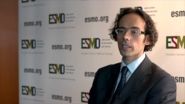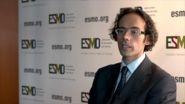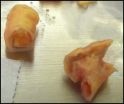(Press-News.org) VIDEO:
R.Califano explains why ESMO Young Oncologists launched a survey on common clinical practice for incompletely resected lung cancer and analyses interesting results claiming for more adherence to guidelines and more...
Click here for more information.
Lugano, Switzerland, 10 June 2014 -- A landmark survey of more than 700 specialists provides crucial real-world insight into the treatments most oncologists choose for lung cancer patients whose tumour has been incompletely resected, an expert from the European Society for Medical Oncology (ESMO) says.
Jean Yves Douillard, from the ICO Institut de Cancerologie de l'Ouest René Gauducheau, France, Chair of the ESMO Educational Committee, was commenting on a paper published in the journal Lung Cancer[1]. In the study, researchers led by Raffaele Califano of The Christie NHS Foundation Trust, Manchester, UK, surveyed 768 oncologists from 41 European countries about the treatments they offered patients who had "R1 resected" non-small-cell lung cancer[2].
R1 resection is a term used by oncologists to indicate that it is possible to find microscopic evidence of cancer cells remaining after a cancer has been surgically removed.
"We know that incomplete resection, or R1 resection, is associated with a higher risk of relapse but there are currently no strong evidence-based recommendations on how to treat these patients after surgery," Douillard says.
"This study is important since it provides a good overview on how the problem is handled in clinical practice all over Europe by practitioners who treat lung cancer."
Overall, 83% of experts surveyed were medical oncologists --specialists trained to treat cancer using chemotherapy, targeted therapies, immunotherapy and other medications.
Of the respondents, 91.4% prescribed chemotherapy, mostly cisplatin/vinorelbine or cisplatin/gemcitabine. The survey showed that the majority of doctors (85%) discussed with the patient the fact that there was limited clinical evidence to guide treatment options. Almost 50% of participants prescribed radiotherapy, with radiation oncologists most likely to offer this treatment approach.
"Treating physicians clearly believe in what they do, and try to provide the best for their patients," says Douillard. "According to the survey, however, practice is heterogeneous and varies according to the specialty of the treating physician—whether they are radiation oncologists or medical oncologists. This is why treatment decisions are best made by multidisciplinary teams."
The evidence gathered in this survey is supported by the recommendations of the 2nd ESMO Consensus Conference on Lung Cancer held in 2013, Douillard notes. That group of worldwide recognised experts recommended adjuvant chemotherapy and adjuvant radiation in R1 resected patients.
The authors of the latest paper call for prospective trials to be undertaken to provide stronger evidence to guide post-surgery treatment in this situation. Douillard agrees that such trials would be informative.
"However, trials of adjuvant treatment in R1 resected lung cancer would be very difficult to design and perform, as this is fortunately an infrequent occurrence. R1 resection would also need to be clearly defined in such studies, as it actually represents a quite heterogeneous group."
"Based on evidence from clinical trials in resected patients in whom all tumour cells have been completely removed, there is a rationale for using both chemotherapy and radiotherapy in R1-resected non-small-cell lung cancer," Douillard says.
"As the authors of this survey state, definitive proof would come from a randomised clinical trial, although such studies would be difficult to perform."
INFORMATION:
Notes to Editors
References
[1] http://www.lungcancerjournal.info/article/S0169-5002(14)00131-7/ (Lung Cancer, Vol. 85/1, pp. 74-80)
[2] http://www.youtube.com/watch?v=Hs9_LWC51c0&feature=youtu.be
About the European Society for Medical Oncology
The European Society for Medical Oncology (ESMO) is the leading European professional organisation committed to advancing the specialty of medical oncology and promoting a multidisciplinary approach to cancer treatment and care.
ESMO's mission is to advance cancer care and cure through fostering and disseminating good science that leads to better medicine and determines best practice.
As a trusted organization with 35 years of experience, ESMO serves its 7,000 members and the oncology community through: a brand of excellence in post-graduate oncology education and training; leadership in transforming evidence-based research into standards of cancer care in Europe; dedicated efforts to foster a more favorable environment for scientific research; innovative international platforms to share expertise, best practices and disseminate the most up-to-date scientific research to as wide an audience as possible.
ESMO's scientific journal, Annals of Oncology, ranks among the top clinical oncology journals worldwide. ESMO events are the meeting place in Europe for medical oncologists to update their knowledge, to network and to exchange ideas.
To find out more about ESMO, please visit: http://www.esmo.org
ESMO survey sheds light on common clinical practice for incompletely resected lung cancer
A survey by the ESMO Young Oncologists Committee
2014-06-10
ELSE PRESS RELEASES FROM THIS DATE:
Game changer for leukemia therapy
2014-06-10
Australian researchers are zeroing in on a promising new approach to killing off cancer cells in patients with leukemia.
In a study led by the South Australian Health and Medical Research Institute (SAHMRI) and the University of Adelaide's Centre for Personalised Cancer Medicine, researchers have found that cancer cells decide whether to live or die after a short period of intense exposure to targeted therapy, opposing the current requirement for continuous treatment.
The researchers say this study presents a new treatment strategy which will translate to a significant ...
Women appear in only 5 percent of sports newsprint
2014-06-10
This news release is available in Spanish.
Women are the subject of news in sports papers in only 5.11% of the cases, sometimes alone (2.18%) and others accompanied by men (2.93%). On the other hand, men are the focus of this kind of information in 92.2% of the cases, according to a study presented recently by UC3M professor Clara Sainz de Baranda at the II International Conference on Gender and Communication. "The remaining 5% is neutral information, which is why, in these kinds of topics, like soccer balls, fields, field houses and goals, men appear more often ...
New teaching approach touted for engineering education
2014-06-10
WEST LAFAYETTE, Ind. – Purdue University researchers who developed a new approach to more effectively teach large numbers of engineering students are recommending that the approach be considered for adoption by universities globally.
The system, called the Purdue Mechanics Freeform Classroom, allows students to interact with each other and faculty online while accessing hundreds of instructional videos and animations. It was pioneered by Charles Krousgrill, a professor of mechanical engineering, and has been used for more than two years in two mechanical engineering core ...
Virginia Tech architect reveals 'green roofs' need not go to great depths to work
2014-06-10
Hot town, summer in the city — it's nothing new, but ways to handle the heat, humidity, and stormwater haven't changed much since the invention of the sewer system.
One solution offered by architectural researchers is known as a "green roof" — a roof covered in living, growing plants to soften the effects of heat, flooding, noise, and stormwater runoff.
Elizabeth J. Grant, an assistant professor of architecture and design at Virginia Tech, will present ways for architects to determine the most effective depths of green roofing for stormwater control on Thursday at the ...
Scientific breakthrough: International collaboration has sequence salmon genome
2014-06-10
Vancouver, BC - Today the International Cooperation to Sequence the Atlantic Salmon Genome (ICSASG) announced completion of a fully mapped and openly accessible salmon genome. This reference genome will provide crucial information to fish managers to improve the production and sustainability of aquaculture operations, and address challenges around conservation of wild stocks, preservation of at-risk fish populations and environmental sustainability. This breakthrough was announced at the International Conference on Integrative Salmonid Biology (ICISB) being held in Vancouver ...
MRI shows brain abnormalities in late preterm infants
2014-06-10
OAK BROOK, Ill. – Babies born 32 to 36 weeks into gestation may have smaller brains and other brain abnormalities that could lead to long-term developmental problems, according to a new study published online in the journal Radiology.
Much of the existing knowledge on preterm birth and brain development has been drawn from studies of individuals born very preterm, or less than 32 weeks into gestation at birth.
For the new study, researchers in Australia focused on moderate and late preterm (MLPT) babies —those born between 32 weeks, zero days, and 36 weeks, six days, ...
Bacteria help explain why stress, fear trigger heart attacks
2014-06-10
WASHINGTON, DC – June 10, 2014 - Scientists believe they have an explanation for the axiom that stress, emotional shock, or overexertion may trigger heart attacks in vulnerable people. Hormones released during these events appear to cause bacterial biofilms on arterial walls to disperse, allowing plaque deposits to rupture into the bloodstream, according to research published in published today in mBio®, the online open-access journal of the American Society for Microbiology.
"Our hypothesis fitted with the observation that heart attack and stroke often occur following ...
Fox Chase doctors urge caution over new analysis of Medicare payments
2014-06-10
PHILADELPHIA, PA (June 9, 2014)—There's much to learn from the recent release of unprecedented amounts of data from the nation's second largest health insurer, Medicare, but only if interpreted cautiously, write two doctors at Fox Chase Cancer Center in the June 9 online edition of the Annals of Internal Medicine.
In April, the Centers for Medicare and Medicaid Services (CMS) released the most detailed data in its history, related to $77 billion worth of physician billings to Medicare. In its analysis of the data, The New York Times showed that only a small percentage ...
Lifetime cancer risk from heart imaging low for most children; rises with complex tests
2014-06-09
DURHAM, N.C. -- Children with heart disease are exposed to low levels of radiation during X-rays, which do not significantly raise their lifetime cancer risk. However, children who undergo repeated complex imaging tests that deliver higher doses of radiation may have a slightly increased lifetime risk of cancer, according to researchers at Duke Medicine.
The findings, published June 9, 2014, in the American Heart Association journal Circulation, represent the largest study of cumulative radiation doses in children with heart disease and associated predictions of lifetime ...
'Jekyll and Hyde' protein linked to type 1 diabetes
2014-06-09
Researchers are a step closer to establishing the link between a protein with a split personality and type 1 diabetes.
New research, published today in the journal PNAS, shows how a protein, called GAD65, changes its shape when it turns itself on and off. Curiously, this characteristic may also link it to type 1 diabetes.
In the human brain, GAD65 performs an essential role: it makes 'neurotransmitters' - chemicals that pass messages between brain cells.
GAD65 is also found in the pancreas. Previous studies linked it to type 1 diabetes because the body makes antibodies ...
LAST 30 PRESS RELEASES:
Sophisticated neuroimaging reveals PTSD in WTC responders is linked to measurable physical changes in brain structure
Health policy experts identify promising strategies for providing health care to homeless people
Study explores role of neutrophils in canine atopic dermatitis
Mayo Clinic researchers develop AI-ECG model to diagnose liver disease earlier
Heavy menstruation common among teenage girls – questionnaire reveals risk of iron deficiency
New study explores why open water swimming feels so powerful for midlife women
In echo of Jurassic Park, mosquitoes capture entire ecosystems in their blood meals
Marty Cooper, Illinois Tech Alumnus and ‘Father of the Cell Phone,’ Receives 2025 Marconi Society Lifetime Achievement Award
How to reduce the risk of lymphedema
NEJM Evidence and CIDRAP announce Public Health Alerts
New fossil study illuminates on the evolutionary success of frogs
Patient-specific human liver model to understand disease mechanisms
Confused by the doctor's questionnaire? U of A study suggests it's common
How do brains stay stable, and when might a dose of flexibility be helpful?
mRNA revitalizes aging immune systems—the liver as a fountain of youth
Rural-urban differences in the prevalence of chronic pain among adult cancer survivors
Food insecurity, burnout, and social isolation among resident and fellow physicians
How do spinal cord injuries heal?
Detailed cell map unlocks secrets of how reproductive organs form
Large language models unleash AI’s potential for autonomous and explainable materials discovery
Gut bacteria have evolved rapidly to digest starches in ultra-processed foods
New risk score helps predict pancreatic cancer recurrence
New evidence challenges understanding of Parkinson’s disease
A new study reveals how embryos and the uterus “talk” during implantation
Cedars-Sinai reports heart attacks, general illness spiked after LA fires
PolyU develops ultra-stable, mucus-inspired hydrogel to boost gastrointestinal wound healing
Flour choice shapes sourdough microbial communities
Can a retinal implant reverse macular degeneration?
Feeding fungi plant remnants produces tasty protein to fortify vegan, vegetarian diets
New tech reduces false positives from breast ultrasounds
[Press-News.org] ESMO survey sheds light on common clinical practice for incompletely resected lung cancerA survey by the ESMO Young Oncologists Committee





